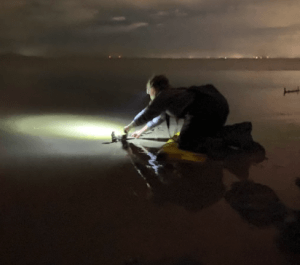
Little bivalve, big impact: how native Olympia oysters help keep our bay healthy
Researchers at China Camp shed light on this important native species
If you ever find yourself on China Camp’s rocky shorelines at low tide, you may notice little round shapes with jagged edges lining the rocks. Consider yourself lucky, because you’ve probably spied native Olympia oysters (Ostrea lureda).

Unfortunately, San Francisco Bay’s native oyster population has plummeted with time. It’s a big loss, since these poker chip-size bivalves, about the size of a poker chip, are important to both humans and the environment. That’s why the Olympia oyster is a primary target for research projects, such as the ones at China Camp conducted by the San Francisco Bay National Estuarine Research Reserve (NERR).
Big benefits abound
Olympia oysters are smaller than the ones you might slurp up at an oyster bar. In fact, wild oysters in San Francisco Bay shouldn’t be eaten, since they can carry heavy loads of pollutants. Though we can’t eat our oysters, we can still reap their many environmental benefits. In the scientific world, these benefits are referred to as “ecosystem services,” meaning services that the environment provides to humans. Remarkably, the ecosystem services that local oysters provide are worth thousands of dollars a year. These services include:
- Slowing waves to reduce shoreline erosion and flooding.
- Helping retain sediment to ward against sea-level rise.
- Creating oyster beds that serve as habitat structures, improving biological diversity and increasing the abundance of many species, including commercially important species such as Dungeness crab.
- Filter-feeding, which cleans bay water to improve clarity and remove pollutants.
Climate change threatens our little oyster
Olympia oysters now face another important challenge: climate change. Climate change is making California’s natural drought and flood cycles even more extreme. When we have a very wet winter, the bay becomes significantly less salty. That’s bad news for Olympia oysters, which are adapted to thrive in salt water.
The bay waters surrounding China Camp turned nearly fresh in the heavy rain years of 2006, 2011, and 2017, killing almost all the oysters at China Camp. Fortunately, a remnant population survived, and the area’s oyster population has rebounded. However, our oysters are likely to be wiped out again as climate change makes extreme weather cycles even more frequent.
To better understand how climate change may impact oysters and other plants and animals, NERR researchers have been regularly monitoring the mudflats and bay bordering China Camp. Studies include checking water quality for salinity and assessing the health of the oyster population. This research helps us understand how oysters and other plants and animals in the Bay Area are being affected by climate change.
By learning more about this issue, we can try to design conservation projects that will help our oyster populations be more resilient in the long term. This will in turn provide those important “ecosystem services,” preserving China Camp’s shoreline, providing habitat, and making our bay waters cleaner.—reported by Allie Margulies, graduate student with S.F. Bay NERR

